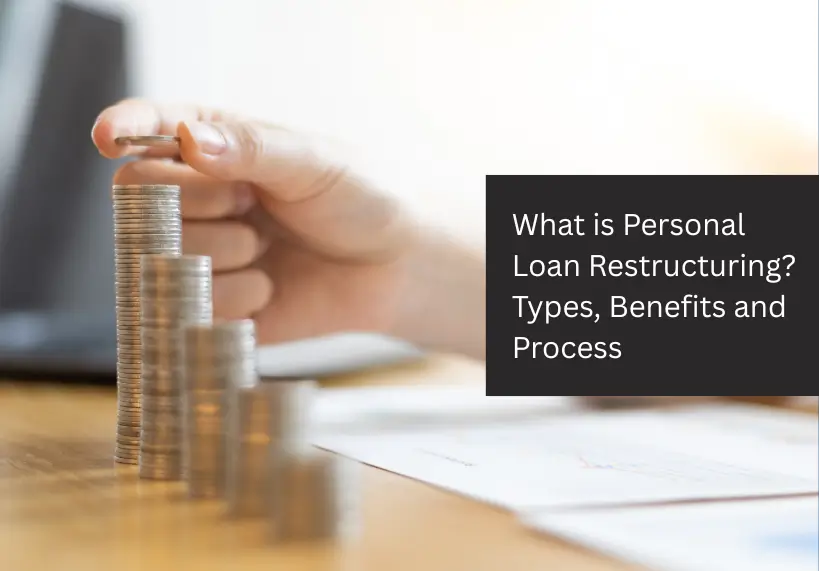
Have your monthly loan payments become difficult to manage? A sudden loss of job or unexpected expense can make it difficult for you to repay your loan on time. That’s where personal loan restructuring comes in. It allows borrowers to renegotiate the terms of their existing loan, offering relief without defaulting.
In this article, we’ll break down what personal loan restructuring really means, the different types of restructuring available, its key benefits, and how you can go about the process. If you’re looking to ease your repayment burden without damaging your credit score, keep reading.
What is Personal Loan Restructuring?
Personal loan restructuring is designed to help you change the terms of your existing loan to make it easier for you to make repayments. This process can be very helpful during times of financial hardship. Instead of defaulting or missing your payments, restructuring allows you to adjust how and when you repay the loan.
Some common changes include lowering interest rates or reducing the monthly EMI amount. The idea is to reduce the financial pressure on you, so you can continue repaying the loan without hurting your credit score too much.
Types of Personal Loan Restructuring
When you’re struggling to repay your loan, lenders in India may offer different ways to restructure it. Here are some common types of personal loan restructuring:
1. Increasing Loan Tenure
Increasing the loan repayment period is one of the most common ways of loan restructuring. Longer tenure means that your monthly repayments become lower. This can make it simpler for you to repay the loan. Keep in mind that a longer tenure may mean that you may have more interest over time.
2. Interest Rate Modification
The lender lowers the cost of your loan by altering the interest rate. You may be presented with the option to switch between a fixed and variable interest rate. Fixed interest rates keep your EMI constant each month, making it easier to plan. Variable rates, on the other hand, may change depending on market conditions—this could help you save money if rates go down.
3. Restructuring Principal Repayment
This involves adjusting how you repay the principal amount. Some lenders may reduce the monthly repayments by extending the loan tenure. Or they may also offer a short period of time where you do not have to make payments. This approach provides temporary relief, which is why it is important to remember that it may increase the total interest paid over time.
4. A Combination of Approaches
Some lenders may use a mix of both interest and principal restructuring. For example, they may reduce the interest rate, give you a break from payments, and extend your repayment period. This customised approach makes sure the new terms are better suited to your current financial needs and goals.
Benefits of Personal Loan Restructuring
- Lower Monthly Repayments: This makes it easier for you to better manage your finances by reducing your monthly repayments.
- Avoid Default: By restructuring your loan, you can avoid missing payments that may have damaged your credit score.
- Protect Your Credit Score: In order to maintain a healthy credit score, you need to consistently follow the revised repayment plan.
- Flexible Solutions: Lenders may offer repayment terms tailored to your financial situation.
- Convenient Process: Some lenders offer easy access to restructuring options through their mobile apps or websites, like LoanTap.
The Process of Personal Loan Restructuring
1. Review Your Current Finances
You should start by assessing your current income and loan amount. You will have a better idea of how much you can afford to pay each month.
2. Contact Your Lender
Get in touch with your lender and explain your situation. Most lenders in India have a team to handle such requests.
3. Submit Required Documents
You will need to provide proof of your financial difficulties. Depending on your situation, you may have to provide the lender with bank statements or salary slips.
4. Sign New Agreements
The lender will offer you new terms once your request has been approved. Make sure to review the details carefully and sign the new agreement to finalise the restructuring process.
When to Consider Personal Loan Restructuring
You should consider personal loan restructuring when you’re facing genuine financial stress and are unable to repay your loan. Restructuring helps you stay on track with your finances without defaulting. It’s a smart option when you want to lessen your financial burden while keeping your credit score and relationship with the lender.
Conclusion
Personal loan restructuring can be helpful when you are under financial pressure and are unable to make monthly repayments. With the help of restructuring, you can ease your monthly burden without harming your credit score by adjusting your repayment terms. If you’re currently managing a personal loan, exploring this option with your lender at the right time can help you stay financially stable and avoid default.
FAQ
1. What is personal loan restructuring?
Personal loan restructuring is a way to change the terms of your existing loan to make repayments easier. It can include lower EMIs, longer tenure, or changes in interest rate.
2. When should I consider restructuring my personal loan?
You should consider it if you’re facing financial problems like job loss, salary cuts, or unexpected expenses that make it hard to pay your current EMIs.
3. Will loan restructuring affect my credit score?
It may affect your credit score slightly, but not as much as missing payments or defaulting on your loan.
4. What documents do I need for restructuring?
You usually need to show proof of income, bank statements, and documents that explain your financial difficulty, like medical bills or job termination letters.
5. Can I refinance a personal loan using a loan app or online platform?
Yes, many lenders offer online options for personal loan refinancing. You can explore their website or loan app to compare offers and apply directly from your phone or computer.








